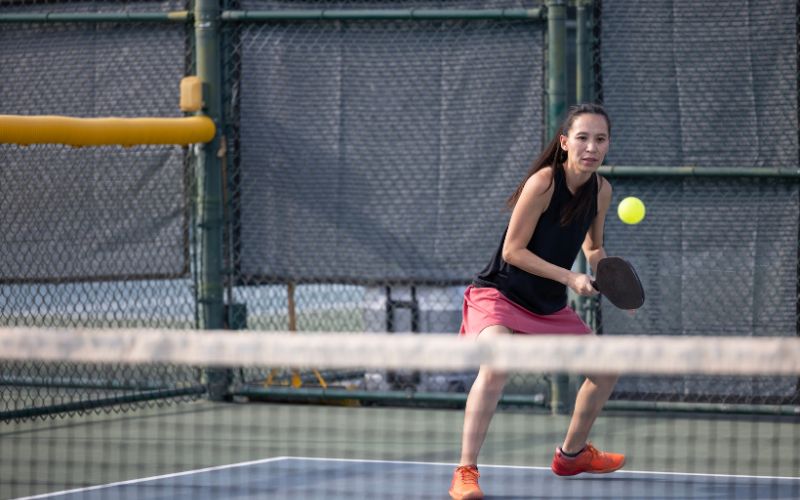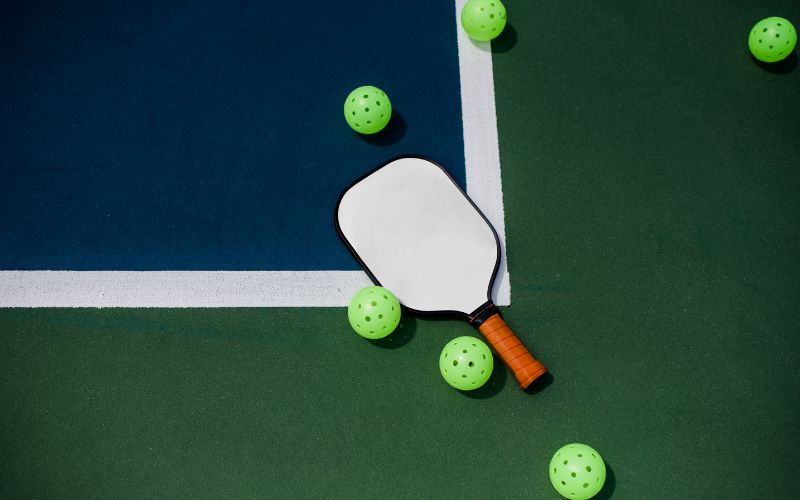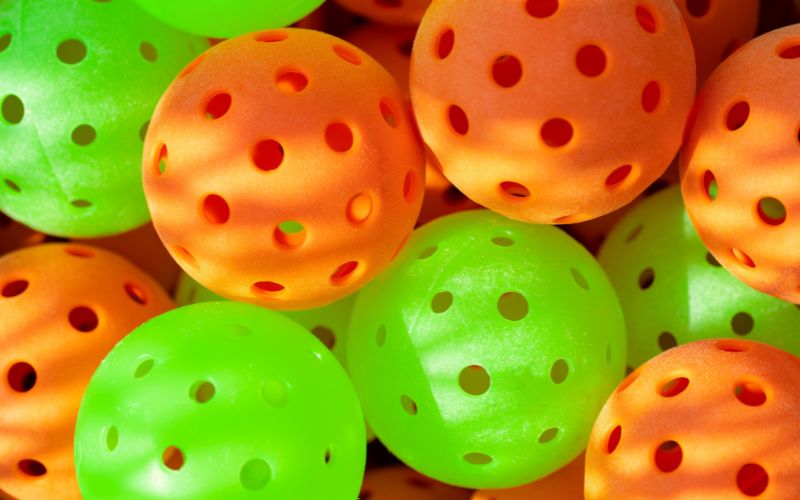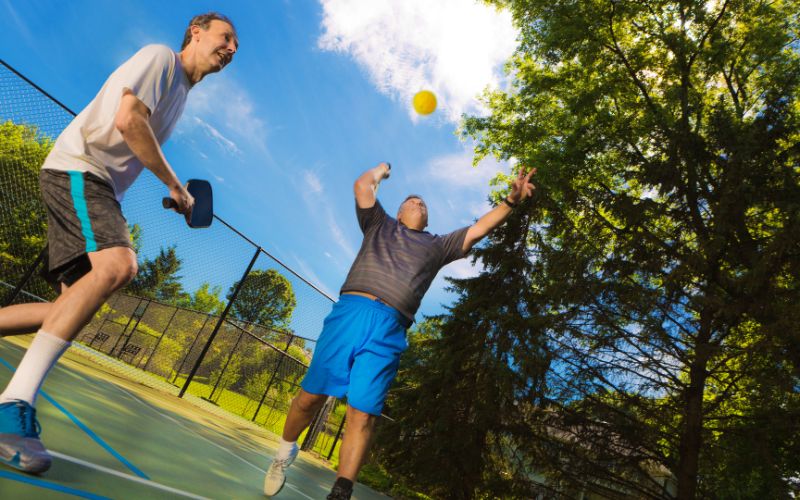Pickleball is a sport that is rich in strategy, skill, and a unique set of terms that can be bewildering to newcomers. Understanding pickleball terms is crucial for anyone looking to take their game to the next level. This article will serve as a comprehensive glossary, detailing essential pickleball terms that every player should know.
Basics Pickleball Glossary
Before we dive into the more advanced pickleball terms, let’s cover the basics.
Serve
In pickleball, the serve is the initial stroke that starts play. It is performed underhand and must be hit at a low-to-high motion, with the paddle making contact with the ball below the waist level. The serve must be made diagonally, landing in the opponent’s service court.
Unlike tennis, only one serve attempt is allowed, and it must clear the non-volley zone, commonly referred to as the kitchen. The serve cannot land in the kitchen; it must land beyond it. The server must also keep both feet behind the backline when serving.
Volley
A volley in pickleball is a shot that is hit out of the air before the ball bounces on the court. This is a crucial part of offensive play and is typically used to keep the ball away from the opponents, making it harder for them to return.
However, there is a critical rule in pickleball known as the “non-volley zone rule,” which prohibits players from volleying the ball while standing in the non-volley zone (the kitchen). This rule is designed to prevent players from dominating the net play too aggressively.
Rally
A rally is a sequence of back-and-forth shots between players after the serve and before a point is scored. A rally continues until the ball is hit out of bounds, does not clear the net, or is volleyed from the non-volley zone.
Rallies can be fast-paced exchanges at the net or can involve strategic placement of shots to move opponents around the court. The rally is where the majority of pickleball play occurs and is critical for building up points or defending against opponents’ attacks.
Dink
A dink is a soft, controlled shot that is typically played from near the non-volley zone line into the opponent’s non-volley zone. The purpose of a dink is to arc the ball just over the net, making it drop into the kitchen.
This type of shot is strategic, as it forces the opponent to hit upward on the ball, limiting their ability to attack aggressively. Drinking is a finesse move that requires precision and touch, and it’s an essential skill for high-level pickleball play.
Kitchen
“The Kitchen” is the colloquial term for the non-volley zone in pickleball. This is the 7-foot area extending from the net on both sides of the court. Players are not allowed to volley the ball from within the kitchen; they must let the ball bounce first, which is a rule designed to reduce the advantage of net play. The kitchen rule adds a layer of strategy to the game, as players must be mindful of their position relative to this zone during play.
Advanced Pickleball Terms
As players progress, they encounter more nuanced aspects of the game. Here are some advanced terms that are commonly used among seasoned players.
Stacking
Stacking is a strategic formation used by a pickleball team where both players position themselves on the same side of the court while one is serving or receiving. This allows the serving team to set up their preferred forehand or backhand shots, and it can also be used to confuse the opposing team. After the serve, players quickly move to their standard positions to continue play. Stacking requires good communication and quick movement to maintain continuous play without leaving the court vulnerable.
Erne
The Erne is an advanced pickleball shot where a player jumps from outside the non-volley zone (the kitchen) to hit the ball in the air over the non-volley line and then lands outside the kitchen. This maneuver allows the player to hit an overhead shot or volley shot without committing a foot fault in the kitchen. It’s named after Erne Perry, who popularized this offensive shot. The Erne can catch the opposing team off guard and is often used as a surprise attack.
Poach
To poach in pickleball is to cross into your partner’s area to hit the ball, typically done when a player anticipates a weak return from the opposing team. It’s an aggressive move that can result in a powerful overhead shot or a passing shot that can win the point. However, poaching must be done with caution to avoid leaving one’s side of the court open for a counterattack.
Third Shot Drop
The third shot drop is a type of drop shot volley that the serving team uses after the return of serve. Following the double bounce rule, where both sides must let the ball bounce once before volleying, the third shot is a soft shot drop that lands in the non-volley zone. This shot is crucial as it allows the serving team to transition from the baseline to the net and set up for a dink shot or a more aggressive pickleball shot.
Dink Shot
A dink shot is a soft, finesse pickleball shot played from near the non-volley line that barely clears the net and drops into the opponent’s non-volley zone. It’s a strategic shot that forces the opposing team to hit the ball upward, limiting their ability to launch an offensive shot. The dink shot is a fundamental part of high-level pickleball play, requiring precision and control with the pickleball paddle.
Volley Shot
A volley shot in pickleball is when a player hits the ball out of the air before it bounces. It’s a quick, offensive shot that keeps the ball in continuous play and can be used to apply pressure on the opposing team. However, when hitting the ball on a volley, the player must ensure they do not commit a foot fault by stepping into the non-volley zone.
Overhead Shot
An overhead shot is a powerful pickleball shot typically used when the ball is high in the air, allowing the pickleball player to hit the ball in a downward motion, often resulting in a point. It’s similar to a smash in tennis and is considered an offensive shot. The overhead shot can be used as a forceful return against a high lob or as a finishing move when the opposing team is out of position.
Strategic Play
Understanding the following terms is key to developing a strategic approach to pickleball.
Lobbing
Lobbing is a strategic play used in both singles and doubles pickleball, especially during a pickleball tournament where high-level strategies are crucial. A lob is a shot where the ball is hit in a high arc, going over the opponent’s head and ideally landing close to the baseline.
The objective is to move the opponents away from the net, forcing them to hit the ball immediately on the return, often resulting in a weaker shot that can be capitalized upon. However, executing a lob requires precision, as a poorly hit lob can be easily smashed by an opponent.
It’s also important to remember the two bounce rule, which requires the ball to bounce once on each side before volleys are allowed, does not apply to lobs, as they are typically hit from the baseline after the ball has already bounced.
Blocking
Blocking is a defensive strategy in pickleball, particularly useful in doubles pickleball when the pace of play is fast, and the ball is being hit with significant power. A block is essentially a punch shot with very little forward swing.
The idea is to absorb the power of an incoming hard shot and return it softly, so it just clears the net and drops into the opponent’s kitchen, making it difficult for them to generate offensive power on their next shot. This technique requires the player to hold the pickleball paddle firmly and use the opponent’s power against them, redirecting the ball back over the net.
Baiting
Baiting in pickleball is a psychological strategy where a player will intentionally hit a shot that tempts the opponent into responding with a specific, often aggressive, shot. For example, a player might hit a slightly high soft shot, baiting the opponent into attempting a smash.
The baiting player is prepared for this and positions themselves to block or counter the expected hard shot. Baiting requires anticipation and a good understanding of the opponent’s habits and tendencies. It’s a risky play because if the opponent reads the bait, they might hit an unexpected shot, catching the baiting player off guard.
Scoring and Line Calls
In pickleball, scoring and line calls have their own set of terms.
Ace
A serve that is not touched by the opponent and results in a point.
Let
A serve that touches the net but lands in the correct service box, which is then reserved.
Side Out
When the serving team violates a rule or loses the rally, resulting in the serve transferring to the opposing team.
Baseline
The line at the back of the pickleball court.
Centerline
The line that divides the service areas on each side.
Pickleball Equipment
Every sport has its equipment, and knowing the terms related to pickleball gear is essential.
Paddle
The tool players use to hit the ball, which is smaller than a tennis racket but larger than a ping-pong paddle.
Ball
The plastic ball with holes played in pickleball, similar to a wiffle ball.
Net
The barrier that divides the court into two equal halves.
Pickleball Court Layout
Understanding the layout of the court is crucial for both playing and making calls.
Non-Volley Zone (NVZ)
Also known as the kitchen, it’s the area of the court where volleys are not permitted.
Service Box
The area of the court where the serve must land for it to be considered in play.
Sideline
The line that runs perpendicular to the net and marks the boundary of the court.
Pickleball Strategy
Strategy in pickleball is a complex interplay of shots, movements, and decisions.
Soft Game
A style of play that emphasizes control and placement over power.
Hard Game
A style of play that emphasizes power and speed.
Drive
A fast, flat shot intended to put pressure on the opponent.
Frequently Asked Questions
As part of the learning process, players often have questions about the terms and rules of pickleball.
What is a ‘dead ball’ in pickleball?
A ball that is no longer in play due to a fault or other stoppage in play.
Can you volley the ball from the kitchen?
No, volleys must be hit outside of the non-volley zone.
What does ‘side out’ mean?
It refers to the serving team losing the serve after a fault.
For a deeper dive into the rules and terms of pickleball, including FAQs, check out this resource:







